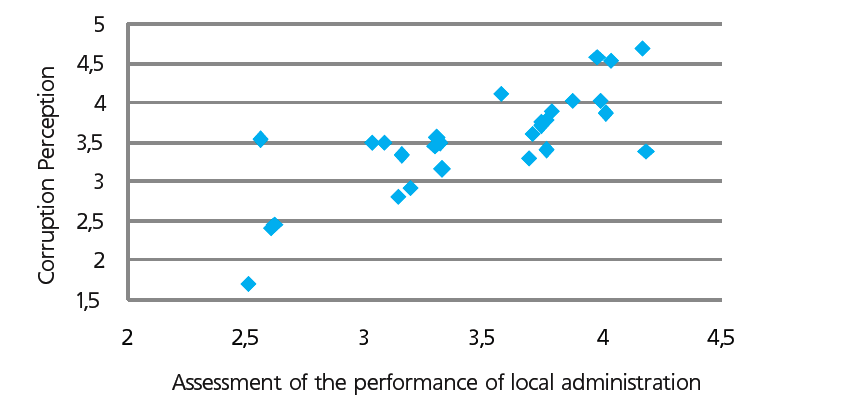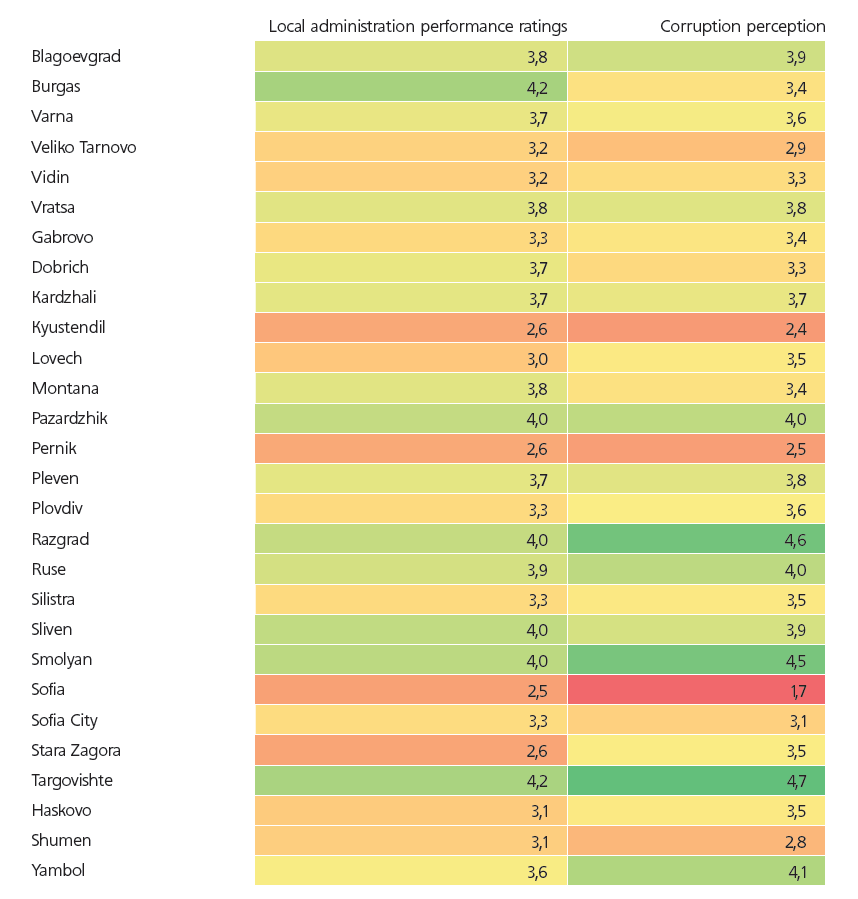Business Surveys: Corruption and Poor Administration Go Hand in Hand
In May, a number of surveys were conducted among businesses and citizens in all 28 districts of the country for the purposes of this study. The aim of the surveys was to supplement the statistical information available with the subjective perceptions of the business environment and living conditions in separate districts.
The results of completed surveys among businesses and citizens outline some intriguing results and interdependencies which deserve our attention. Given the importance of corruption and the operation of administrative services for the business environment in each district, most questions in the survey addressed to business representatives dealt with these two issues. Below is a summary of the results:
Corruption
- Considering the relatively high level of corruption in the country compared to other EU countries, judging by the internationally recognised Corruption Perception Index developed by Transparency International, major differences were reported between separate districts. Contrary to expectations, there are quite a few districts in the country where the level of corruption perceptions is very low, i.e. local business people and citizens believe that the level of corruption in their particular district is very low. Thus, judging from the surveys conducted within the business community, the districts of Razgrad, Targovishte and Smolyan appear to be "corruption-free”; the average score for these districts is between 4 and 5, where 4 means a low corruption level, and 5 means very low. These perceptions for minimum levels of corruption were confirmed also by the results from the survey among citizens in the Targovishte District, but not for the other 2 districts, i.e. based on data from the surveys conducted, it would be safe to say that Targovishte is perceived as a district with a very low level of corruption both by local companies and by citizens.
- At the other end of the spectrum are the most corrupted municipalities according to perceptions reported by businesses. Among them the absolute "champion" is Sofia, with an average score of 1.71, where 1 is a "very high level" of corruption, and 2 means a "high level". Pernik and Kyustendil are in the „top three” with an average score close to 2.5, i.e. between "high" and "medium" corruption level. Shumen and Veliko Tarnovo also stand out with higher than average levels of corruption.
- The questionnaires for businesses' perceptions of corruption contained questions divided according to the various institutions where such practices could be encountered: municipal administrations, district administrations, regional state institutions (e.g. Labour Inspections, Labour offices, Social Assistance Directorates etc.) the police, and judicial institutions. Generally, questionnaires completed by companies made no clear distinctions between local institutions in terms of corruption. In other words, the differences between the levels of corruption in various institutions within the same district are small and the levels of corruption are similar. In several districts, however, there are noticeable differences between institutions, with the high level of corruption in the judiciary and police outweighing the better results for other institutions covered by the survey. These are for example the district of Burgas and Sofia (capital) District where the police and the judiciary are perceived by businesses as far more corrupt than other institutions.
- In addition to the general perceptions of corruption in various local institutions, the business survey sought to outline the procedures providing the richest "feeding ground" for corruption. Towards that effect, business representatives were asked how often (in their sector of operation) companies have to make corrupt or "irregular" payments. The questionnaire listed several common cases of companies interacting with local authorities. These cases included public procurement deals, registrations and permits from local government services, administrative services provided by local authorities, etc.
It is noteworthy that businesses were generally not overly critical of informal payments. On the one hand, it may be due to the lack of experience or direct observations of such practices, on the other, due to the non-exhaustive list of examples of situations in which businesses most commonly interact with local authorities, or, thirdly, the responses might just be guided by reluctance to go into details about common corruption practices. Judging by the responses to this particular question, it can be concluded that informal payments are relatively rare in the country, except for several districts. For comparison, when it comes to corruption, rather opposite is true: it is a relatively widespread phenomenon across the country, with a few exceptions only.
Nevertheless, Pernik District managed to re-confirm its leading position in the area of informal payments, too; these practices are the most frequently encountered in Pernik when compared to the rest of the country. Sofia (capital) is also reported for the common use of unofficial payments. Another interesting observation from the survey is that such payments, where considered "common practice" by businesses, have been reported in all the cases listed, i.e. if there are perceptions of informal (facilitation) payments, they are widespread in the entire district: for public procurement, various administrative services, permits, etc.
A similar situation is also observed with corruption, where the overall differences in perceptions between separate institutions within the same district are small. This interdependence could be revealing a "contagious" effect where corruption perceptions are concerned: if one or more institutions in the same district are considered corrupt, then this results in the rapid infiltration of corruption practices into other institutions, or automatically creates similar public perceptions of corruption in other institutions, too.
Interaction with Local Administration
The evaluation given by businesses of the work of local municipal and district administrations is largely consistent with the results on corruption. The districts with relatively high perceptions of corruption are also the districts where businesses give the lowest score to local administration's performance. Among these are the districts of Sofia, Pernik, and Kyustendil, with a score of 2.5-2.6 on a scale from 1 to 5, where 1 means "major flaws", and 5 means "no flaws". Somewhat surprisingly, the group of districts with relatively low scores for local administration performance includes Stara Zagora that is not listed in the category of corrupt districts.
Similarly to the indicators discussed earlier, although the question about the operation of municipal and district administrations allows for separate scores in several areas - competence of staff, speed, friendliness, etc. the same propensity to small variance between separate scores is observed within each district. Administration employees are either perceived as being quick, competent, friendly and incorruptible, or quite the opposite, but mixed „typologies” (for instance highly competent and corrupt at the same time) are generally not observed.
Meanwhile at the other end of the scale are Burgas, Pazardzhik, Razgrad, Targovishte, and Smolyan with scores of about 4, having in mind that the scale is between 1 – "major flaws" and 5 – "no flaws". In these districts, administration is perceived as having no major flaws. It should be noted that three of these five districts - Razgrad, Targovishte, and Smolyan - are also characterized by some of the lowest levels of corruption perceptions.
Obviously there is some positive correlation between the two indicators - corruption perceptions and assessment of the administration's performance. This correlation is clearly seen in the scatter plot below where the separate districts are placed along the two axes – corruption perceptions and assessment of the administration's performance.
Graph 1: Relation between Corruption Perception and Businesses’ Assessment of the Performance of Local Administration

Source: Surveys conducted among businesses
The average assessments of corruption and local administration's performance by district and the statistical characteristics of correlation between the two indicators have confirmed these findings. The correlation between the two indicators is positive (0.78) and shows a very high degree of connection between these two indicators. If corruption perceptions in a given district are high, then we can reasonably expect that the score given to local administration's performance would be relatively low, and vice versa. It is important to emphasise that this correlation does not imply causality between the two indicators but only parallel movement. I.e. we cannot claim that the poor performance of administration leads to corruption or conversely, that where local authorities are corrupt, it brings down the quality of services they provide. The only conclusion we could draw about this relatively high positive correlation is that often corruption and the unsatisfactory services provided to businesses and citizens by local authorities are related phenomena.
Table 1: Relation between Corruption Perception and Businesses’ Assessment of the Performance of Local Administration

Source: Surveys conducted among business
Key: The cells shaded in red mean low scores given to the performance the administration and high level of corruption perceptions. Conversely, green cells correspond to low corruption perception and high scores to the administration's performance.
E-government
Both in business surveys and the questionnaires about municipalities included some questions about the level of provision and use of electronic services by the district / municipal administration. The majority of respondents stated that they had not used electronic services provided by local authorities. The only districts where the number of users of such services prevails above the number of those who do not use them include Blagoevgrad, Sofia, Stara Zagora, and Haskovo. Among the districts with the lowest percentage of respondents who have used e-services in the past year are Kyustendil (6.3%), Smolyan (8.2%), Sliven (12.2%), Lovech (13.3%), Vidin (16.3%), and Yambol (16.3%). Interestingly, even in the capital, that has the largest concentration of young and educated population in the country, respondents who have not used these services still slightly outnumber those who have.
In conclusion, there is a strong positive connection between corruption perceptions and the assessment of local administration's performance. The districts standing out as highly corrupt are also among the districts with relatively low scores for the administration's performance. The districts of Sofia, Pernik, and Kyustendil are the worst performing and the most corrupt ones, while the best performing and respectively "cleanest" from corruption are Razgrad, Targovishte, and Smolyan. Perceptions of both corruption and the performance of local institutions are relatively homogeneous, i.e. within the same district relatively small differences are observed in perceptions of corruption and unofficial (facilitation) payments between separate institutions or with respect to various administrative services. Also slight is the variance regarding different aspects of the administration's work: competence, integrity, speed, etc. If the local administration in a given district is perceived as poorly performing, then this perception is all-inclusive, so the administration as a whole is perceived as slow, incompetent, and prone to bribery.
In terms of e-government, surveys among businesses and the municipal administration have confirmed our expectation that the electronic services provided by local authorities are only used by a limited number of business representatives. In most districts (except for four: Blagoevgrad, Stara Zagora, Haskovo and Sofia) respondents who declared that they had not used such services in the last year, far exceed the number of actual users.
